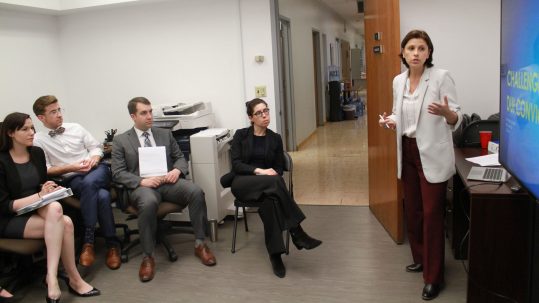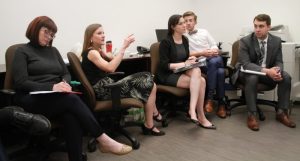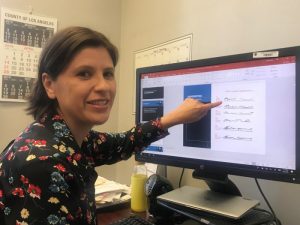News
High Tech and Misdemeanors
 The father took his young daughter for sandwiches at Subway. But police claimed he was speeding on his motorcycle and fleeing officers at that time. Police said they recognized him as someone they had pulled over before and noted his distinctive motorcycle.
The father took his young daughter for sandwiches at Subway. But police claimed he was speeding on his motorcycle and fleeing officers at that time. Police said they recognized him as someone they had pulled over before and noted his distinctive motorcycle.
They sent him a letter saying he was being charged with reckless driving. Although a misdemeanor, he faced six months in jail.
Once a Los Angeles County Public Defender client, the first instinct was to review the surveillance camera at the Subway to verify the man’s whereabouts. But Deputy-in-Charge Karla Sarabia suggested something more high tech. She wanted to use his cell site location data to exonerate him.
Gaining access to the client’s MapQuest app, the team tapped into his stored GPS locations. They downloaded the data directly from the cloud to see where the man had traveled. During the time in question, he had been far from the alleged crime scene and indeed at a Subway.
The case was dismissed.
“For our clients, getting a DUI or even a misdemeanor conviction is a big deal,” Sarabia said. “Once you have a DUI or a misdemeanor on your record, you miss work, may lose your job and it’s a downward spiral.”
 Deputy Public Defender Kim Repecka makes a point during training with Deputy Public Defenders from left: Aine Thein, Kathleen Fischman, Evan Ponec and Kevin Johnson.
Deputy Public Defender Kim Repecka makes a point during training with Deputy Public Defenders from left: Aine Thein, Kathleen Fischman, Evan Ponec and Kevin Johnson.
Sarabia trains new deputy public defenders how to incorporate experts and high technology into their misdemeanor cases. Take the case of the man wrongly accused of reckless driving.
“The prosecutor narrative is always, ‘This is a case about credibility and who are you going to believe?” Sarabia said. “ ‘These officers or this person accused of a crime?’ My goal for the new generation of attorneys is to show how that is a losing proposition for us. Technology changes the narrative. Now it’s, ‘Who’s lying, the police or the technology?’ ”
All new attorneys train for a year, the final 14 weeks with Sarabia at the Metropolitan Courthouse before completing probation and taking their own misdemeanor cases. She brings in consultants who teach on the newest methods of jury selection, and experts to show how to use accident reconstruction, handwriting and morphometric analysts on cases.
 In her training, Sarabia discusses incorporating handwriting analysis. In one case, a client was pulled over for a traffic infraction and learned a warrant was issued for his arrest after he allegedly never resolved a ticket for driving under a suspended license. The client said the person who signed the citation wasn’t him. The handwriting expert agreed. The case was dismissed after the expert’s analysis was submitted.
In her training, Sarabia discusses incorporating handwriting analysis. In one case, a client was pulled over for a traffic infraction and learned a warrant was issued for his arrest after he allegedly never resolved a ticket for driving under a suspended license. The client said the person who signed the citation wasn’t him. The handwriting expert agreed. The case was dismissed after the expert’s analysis was submitted.
“Every known signature in his DMV file was examined,” Sarabia said. “In his case we were able to show that our client was not the person who was pulled over and ticketed for driving with a suspended license.”
Then there are cases of mistaken identity. Morphometric experts can help clear the wrongly accused. In one, a client was taken to jail after police insisted he had committed a hit and run based on a still photograph from video taken at the accident scene.
 Sarabia also trains on using morphometric experts in misdemeanor cases.
Sarabia also trains on using morphometric experts in misdemeanor cases.
“We gave the image to a morphometric expert who then used various points like the top of his ear and was able to determine that our client was not the person who committed the crime,” Sarabia said.
Accident reconstruction reports help in many ways, even when they don’t prove the client’s innocence. For example, a client was accused of vehicular manslaughter after he struck a person crossing the street, who later died. The client believed that two cars in front of him obstructed his view. The expert determined that the cars did not hinder his view of the pedestrian.
“In that case, even though we never used the expert’s simulation, the simulation allowed us to understand how the accident had unfolded,” Sarabia said. “This allowed us to negotiate for a lesser charge. Our client ended up pleading to reckless driving, a substantially better disposition than pleading to a vehicular manslaughter.”
This exemplified how, even when an expert’s report is not used in trial, the expert’s input can provide important information about cases, she said.
Sarabia pointed out that trials today vastly differ from trials of yore.
“The science and the technology has helped us more than it could ever hurt us,” she said. “We need to embrace technology and new scientific developments.”
She said the Public Defender’s Office takes misdemeanor training very seriously.
“Even though some think this may be too high tech for such a minor case, I don’t believe there is any such thing as a minor case,” she said. “We will use experts and reconstructions on trespass cases. We will do it on anything to help our clients.”
Deputy Public Defender Kimberly Repecka, training under Sarabia, emphasized that requesting an expert in a misdemeanor case is not only for actual testimony, but to educate on the issues.
“It’s easy to be overly goal-oriented and to make assumptions about what the facts will be in trial,” Repecka said. “It’s important to view every part of the process as a potential defense for the client, because you never know what actual facts will come out in trial.”
Repecka said that even if an expert doesn’t turn out to be a good witness to call affirmatively at trial, they learn from them.
“It serves to make us better attorneys in future cases,” she said.
